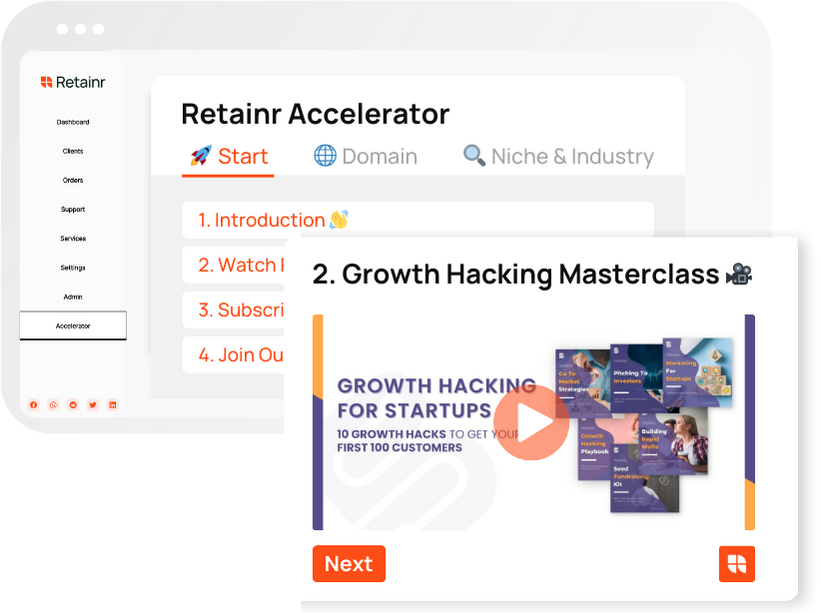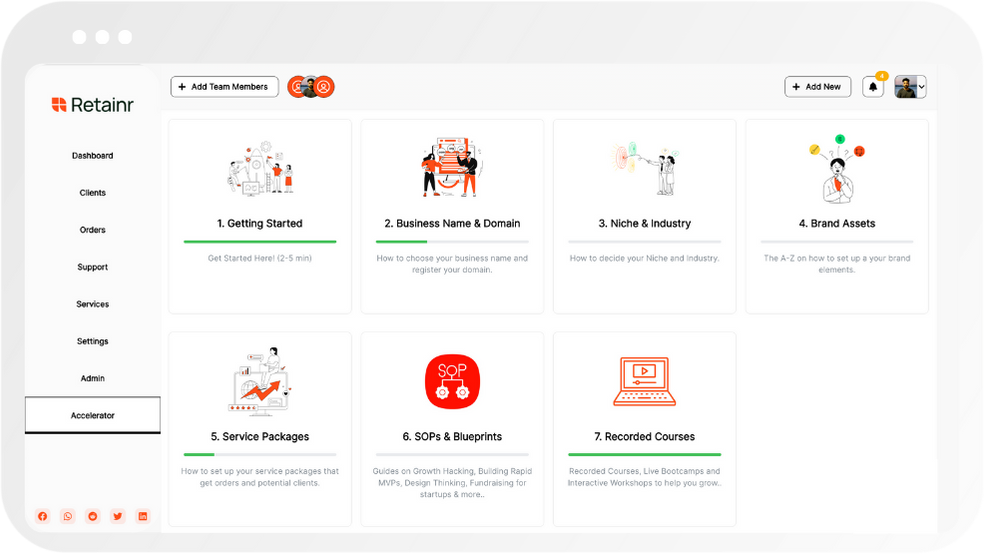
7 Key Steps To Implementing AI In Your Business
Build with Retainr
Sell your products and services, manage clients, orders, payments, automate your client onboarding and management with your own branded web application.
Get Started1. What are the key steps in implementing AI in my business?
Understand Your Business Needs
One of the first steps to implementing Artificial Intelligence (AI) in your business involves understanding your business needs and identifying areas where AI can bring improvements. This includes a deep analysis of the challenges and bottlenecks in your current processes and determining how AI can help.
- Define the problem you want to solve with AI
- Check areas where automation can bring efficiency
- Consider how AI can enhance customer experience
Select the Appropriate AI Technology
After understanding your business needs, the next step is to choose the right AI technology that fits your needs. This can be Machine Learning (ML), Natural Language Processing (NLP), or Robotic Process Automation (RPA) and others. The technology should align with the problem statement you're addressing.
| AI Technology | Use Case |
|---|---|
| Machine Learning | Predictive Analysis, Data Mining, etc. |
| Natural Language Processing | Chatbots, Language Translation, etc. |
| Robotic Process Automation | Automated Marketing, Customer Service, etc. |
Develop a Data Strategy
The third step in implementing AI for your business involves developing a comprehensive data strategy. AI algorithms often require a large amount of high-quality data to function effectively. This strategy should cover data collection, data cleaning, data storage, and data security... etc. Remember data is the fuel of AI.
- Identify the data sources available
- Establish a data mining process
- Institute a robust data security and privacy framework
- Determine analytics tools and methods for data interpretation
2. How do I start the process of introducing AI to my business?
Starting the Process of Introducing AI to Your Business
Adopting artificial intelligence in your business starts with identifying the areas where AI can improve efficiency and profitability. This might include repetitive tasks, data analysis, customer service, supply chain management, or sales predictions. Once the areas are identified, the next step is to assemble a team comprising data scientists, IT specialists, and subject matter experts to plan and manage the transposition.
- Identify Area: Look for the sections and departments in your business that could benefit from the efficiency of AI. This could be any area from customer service to data analysis.
- Assemble Team: An ideal team should at least consist of Data Scientists, IT specialists, and SMEs (Subject Matter Experts) who can create a blueprint for the implementation of AI.
Training and Optimization
Once the team is set up and the areas are identified, the next steps involve training the AI algorithms to handle tasks and optimize them as per business needs. Initially, the algorithms are trained with historical data to help them learn and make predictions and gradually improve with time.
| Step | Description |
|---|---|
| Training | The AI algorithms are trained on historical data, helping them learn patterns and make predictions. |
| Optimization | Based on the learned patterns, the AI algorithms are then optimized to handle and forecast business tasks more efficiently. |
Integration and Automation
Finally, once optimized, these AI algorithms can be integrated into the existing business software. This will automate the tasks, thus improving efficiency and productivity. The integration process may vary depending on the existing technology infrastructure and the nature of the business.
- Integration: The AI algorithms are incorporated into the existing business software.
- Automation: The tasks that the AI has been optimized for will now be automated, thus increasing efficiency and decreasing manual efforts.
3. Can you explain the importance of identifying business problems before implementing AI?
Identification of Business Problems
Before leaping right into integrating AI into your business, it is crucial to identify the problems you want it to address. Identifying these problems will help you pinpoint where AI can bring the most value and prove beneficial to your business. AI can be the solution to various challenges, from improving customer service to streamlining operations. Here are a few common issues businesses face that AI can help resolve:
- Understanding customer behavior and preferences for better marketing.
- Organizing and analyzing large amounts of data.
- Identifying sales opportunities and predicting trends.
- Helping with precision and accuracy in manufacturing processes.
Clarity on Business Issues for Effective Solutions
Once business problems are clearly identified, you're effectively able to determine what AI solutions would best address these issues. This step allows you to extrapolate and compile relevant data, making it easier to train your AI system to meet your business’s unique needs. The following table details four common business problems and their potential AI solutions:
| Business Problem | AI Solution |
|---|---|
| Need for personalized marketing | Use AI to analyze customer preferences and personalize marketing efforts |
| Managing extensive data | Implement AI systems for data management and analytics |
| Identify sales trends and opportunities | AI can assist in predicting sales trends based on historical data |
| Improving precision in manufacturing | AI can increase accuracy and quality control in production processes |
Aligning AI implementation with Organizational Goals
Identification of the business problems provides a direct link between AI implementation and organizational goals. It helps ensure that the introduction of AI into your operations aligns with your company's strategic objectives and can bring about considerable improvements. Moreover, it fosters a sense of transparency and purpose amongst the staff in understanding why the company is utilizing AI.
4. How does choosing the right AI technology impact the implementation process?
Choosing the Right AI Technology for Implementation
Choosing the right AI technology is crucial for the success of AI implementation in your business. This affects not only the speed and smoothness of implementation but also the effectiveness of the AI system in realizing your business objectives. Several factors come into play when selecting AI technology:
- Business Goals: AI technologies are specialized tools aimed at specific tasks. Understanding your business goals is therefore critical in choosing the technology that best aids in achieving these goals.
- Integration: The chosen AI technology should seamlessly integrate with existing business systems. This significantly eases the implementation process and boosts operability post-implementation.
- Technology Maturity: Investing in mature technologies guarantees reliability and comprehensive support, which could be lacking in new, unproven innovations.
Impact of AI Technology Choice on Implementation Process
The choice of AI technology impacts the implementation process in several significant ways. Implementing the right technology influences:
- Time and Cost: A technology that integrates well with your existing systems can greatly reduce the implementation time, and subsequently the cost.
- Ease of Use: User-friendly technologies are easier to adopt and cause less disruption in workflows during the transition phase.
- Effectiveness: The right technology aids in achieving your business goals more efficiently and can drive improved performance in the tasks it’s supposed to automate.
The Right AI Technology: A Decisive Factor
| Right AI Technology | Wrong AI Technology | |
|---|---|---|
| Implementation Phase | Smooth and efficient | Challenges and interruptions |
| User Acceptance | High | Low |
| Meeting Business Goals | High success rate | Poor performance |
Therefore, to ensure that the AI implementation process is seamless, cost-effective, and yields the desired results, it's crucial to choose the appropriate AI technology. Analyzing your business needs carefully and consulting with AI experts will help you make the right choice.
5. How can I plan and design AI models for my business?
Planning AI Models for Your Business
The first step to planning AI models for your business is understanding what AI can do for your organization. Identify problems that AI can solve, areas for improvement or processes that can be automated. You can use a SWOT analysis (Strengths, Weaknesses, Opportunities, Threats) to assess the potential of AI in your business context. Subsequently, set achievable goals and determine the resources you might need, including data, hardware and software, and specialized staff.
- Understand Potential: Assess what AI can do for your business.
- Identify Problems: Look for problems that AI can solve or areas that can be improved.
- Set Goals: Set realistic and achievable goals for your AI implementation.
- Determine Resources: Identify the resources you will need, including data, hardware and software, and talent.
Designing AI Models for Your Business
Designing AI models for your business is a step-by-step process, often iterative. This process includes creating or choosing suitable algorithms, feeding them with relevant data, testing their performance and accuracy, and reiterating to optimize the models. When selecting AI models, remember to consider the scalability of the model and how well it aligns with your business requirements.
| Step | Description |
|---|---|
| Algorithm Selection | Select suitable algorithms based on the task at hand. |
| Data Collection and Preparation | Collect relevant data and prepare it for training the AI. |
| Model Training | Use the prepared data to train the AI model. |
| Model Testing | Test the AI model's performance and accuracy. |
| Model Optimization | Iterate the process to optimize the model's performance. |
6. How do I ensure successful integration of AI with existing processes and systems?
Maintaining Compatibility and Consistency
In order to ensure successful integration of AI into your existing business systems, it's essential to ensure compatibility and maintain the consistency. The initial steps include:
- Defining your needs and identifying which processes can be automated
- Determining which AI tools or applications are most suitable for your identified needs
- Thoroughly testing the proposed AI solutions for compatibility with existing systems
Training Staffs and Continuous Improvement
It’s a paramount step to provide a comprehensive training program for your staff to ensure they fully understand how the AI systems work, and how to get the most out of them. Key steps should involve:
- Explaining the benefits of AI and its applications
- Conducting practical training sessions to let the employees understand the functionality of AI
- Supplying sufficient resources, such as manuals or online guides, for employees to reference
Integration of AI and Existing Processes in a Tabular view
The following table provides a quick snapshot of the steps involved in ensuring effective AI integration:
| Steps for Integration | Description |
|---|---|
| Defining Needs | Identify the processes where the AI can be integrated |
| Selecting Tools | Determine the most suitable AI applications for the business |
| Compatibility Test | Test the AI solution with the existing system |
| Staff Training | Ensure staff understands the functionality of the AI system |
| Continuous Improvement | Constantly improve and adapt based on the feedback |
7. What measures should be taken for training and testing of AI models?
Planning Training and Testing of AI Models
Implementing artificial intelligence (AI) in your business requires a careful planning of training and testing of AI models. Before developing the AI systems, it's crucial to ensure that the business has a well-prepared data strategy. This involves understanding the type of data required, the methods to collect, prepare and clean it, and how to use it efficiently to train the AI models. To further improve the performance, the models should also be continuously fine-tuned and retrained.
- Understanding the Data: It's crucial to clearly understand the data needed for training the models. This may include customer information, sales data, industry reports, and much more.
- Collection and Preparation: The data should be collected from reliable sources and prepared for training. Preparation includes cleaning the data to remove any errors or inconsistencies.
- Model Training: This involves using the prepared data to train the AI models. The better the data and the training process, the more accurate the AI model will be.
- Fine-Tuning and Retraining: The AI models should be continuously fine-tuned and retrained to improve their performance and keep them up-to-date with the changes in the data.
Implementing a Testing Strategy
Testing AI models is as crucial as training them. It not only validates the accuracy of the models but also ensures that they are ready to be deployed. To build an effective testing strategy, several aspects need to be taken into consideration:
| Strategy | Description |
|---|---|
| Testing Plan | Set specific goals and objectives for testing, outlining what needs to be achieved by it. |
| Performance Metrics | Determine what metrics will be used to assess the performance of the AI models. These may include accuracy, precision, recall, and others. |
| Test Data | Select a dataset to test the AI models that is representative of the real-world data it will handle. Ensure it covers all possible scenarios. |
| Continuous Testing | Like the AI models, testing processes should be ongoing. AI systems should be continuously tested and validated to ensure optimal performance. |
8. What is the role of monitoring and managing AI systems in my business?
Understanding the Role of Monitoring and Managing AI Systems in Your Business
Implementing AI into your business operations necessitates a close monitoring and management regime. AI systems require constant surveillance to ensure they function as designed, to prevent any unforeseen glitches, and to track progress towards achieving business objectives. Three primary roles of monitoring and managing AI systems involve maintenance, development, and decision-making.
- Maintenance: AI systems require regular maintenance to check integrity, system vulnerabilities, and to apply necessary updates, improvements, and patches.
- Development: Analyzing system performance data can help in fine-tuning algorithms, and even in the retraining of AI models to boost their efficiency and accuracy.
- Decision-Making: Monitoring AI systems offer valuable insight that can drive strategic business decisions, for instance, through recommendations or identifying areas of improvement.
Importance of Effective AI Monitoring
Effective monitoring of AI systems is not just about ensuring seamless functionality, but also about vital aspects like risk management, compliance adherence, and ethical considerations. AI monitoring is essentially about ensuring the deployment aligns with the intended purpose, while also controlling any potential risks to the business or its stakeholders.
| Aspect | Description |
|---|---|
| Risk Management | Keeps a check on any operational or function errors that could lead to significant business losses. |
| Compliance Adherence | Ensures alignment with regulatory standards and laws, avoiding legal repercussions. |
| Ethical considerations | Maintains transparency and fairness in AI systems and protects your business from criticism. |
Managing AI Systems to Leverage Their Full Potential
Managing AI extends beyond monitoring. It involves optimizing usage, effectively integrating with existing infrastructures, and enabling your team to utilize the system to its fullest potential. Incorporating AI into your business involves strategies and techniques for capitalizing on its capabilities.
- Achieve strategic alignment by identifying areas where AI can add the most value.
- Enable effective integration by ensuring your AI system can collaboratively work with existing business operations.
- Develop your team's capabilities to use the AI system, ensuring they understand how to leverage it effectively.
9. How does communication affect successful AI implementation?
The Influence of Communication in Successful AI Implementation
Effective communication is indispensable in integrating AI into your business. Your team needs to understand the purpose of AI, its benefits, and its working mechanism. Without robust communication, misconceptions, and resistance to new technology may hinder successful AI adoption.
Steps to Encourage Communication During AI Implementation
- Explain the Importance of AI: Clearly communicate with your team about the potential benefits of AI. This should include how AI can automate routine tasks, enhance productivity, and drive business growth.
- Training Sessions: Conduct informational training sessions about AI. The sessions should cover basic understanding of AI, key areas of application within the business and the ethical implications of AI.
- Promote Open Dialogues: Staff members should feel comfortable discussing their doubts and concerns. Addressing these through open dialogue can help to build confidence and acceptance of the new technology.
- Regular Updates: Keep your team updated with the progression of AI implementation regularly. This can make them feel involved in the transformation and reduce resistance.
The Impact of Communication Strategies on AI Implementation Success Rate
| Strategy | Impact |
|---|---|
| Clear communication of AI benefits | This can help to motivate the team and reduce resistance to AI. |
| Training sessions | An informed team can adopt and utilize AI more efficiently, directly enhancing business operations. |
| Promoting open dialogue | Addressing concerns can build trust and acceptance among team members. |
| Regular updates | Makes the team feel involved, thus improving acceptance and reducing resistance towards AI implementation. |
10. Why is it crucial to review and refine AI models post-implementation?
Importance of Reviewing and Refining AI Models
AI models are robust tools with the potential to transform business operations and they need regular maintenance for optimal performance. Reviewing and refining these models post-implementation is crucial due to various reasons. Firstly, the external business environment continually changes, and hence, AI models need to be adapted accordingly to maintain their effectiveness. Secondly, post-implementation reviews can identify potential shortcomings or issues which can be addressed by refining the AI models. Thirdly, businesses can leverage these reviews to assess ROI, ensuring that the AI implementation is delivering value.
- Adapting to External Environment: The performance of AI models can be significantly influenced by external changes such as market trends, regulatory changes, and customer behaviour. Regular reviews can help in updating and fine-tuning the models to remain relevant and effective.
- Identifying Shortcomings: No model is perfect; finding shortcomings post-implementation offers an opportunity to correct them, improving the model’s performance, reliability and accuracy.
- Assessing ROI: Businesses need to evaluate the return on investment from AI implementation. Regular review of how AI models deliver outcomes and contribute to business goals can provide insights into their profitability.
Refining AI Models Post-Implementation
Post-implementation, the AI models need refining to improve their capability, ensure their continuous learning, and keep up with the new data. This process involves the following steps:
| Step | Description |
|---|---|
| 1. Feedback Loop | This involves creating a mechanism to collect feedback about the model’s performance from end-users. |
| 2. Re-training Models | Based on the feedback and new data, the models need to be retrained and tested to improve their performance. |
| 3. Updating Data Sets | If the AI model is performing poorly due to outdated data, then the data sets need to be updated. |
| 4. Continuous Monitoring | This step involves regular monitoring of AI models to ensure their uninterrupted performance and to detect problems in real time. |
Conclusion
Embrace the Future: 7 Key Steps to Implement AI in Your Business with Retainr.io
Implementing Artificial Intelligence (AI) in your business operations can seem daunting, but it doesn't have to be. This blog reveals seven key steps that can make the process straightforward and efficient. If done right, this revolutionary strategy can change how your business functions, driving growth and boosting efficiency.
Understanding AI and Your Business Needs
The first step to implementing AI in your business is understanding AI itself. From machine learning to natural language processing, AI has various aspects. You also need to identify which of your business areas would benefit most from AI integration. Retainr.io can help you clarify these aspects and guide you towards a more digital, AI-driven future.
Creating an AI Strategy
An effective AI implementation requires a well-planned strategy. This involves determining your business goals and how AI can help achieve them. The feature-rich software from Retainr.io provides powerful insights to formulate your AI strategy.
Finding the Right AI Partner
For successful AI integration, you need an experienced, reliable AI partner. Retainr.io is your perfect AI companion, offering a user-friendly platform that simplifies selling, managing clients, orders, and payments with your own branded app.
Managing AI Implementation and Change
Smoothly managing the changes that come with AI implementation is crucial. The team at Retainr.io ensures a seamless transition by not just providing the whitelabel software but also accompanying you every step of the way.
Data Collection and Management
Access to relevant and reliable data is a prerequisite for effective AI. With Retainr.io, you can effortlessly manage massive data collection, storage, and utilization, paving the way for smarter business decisions.
Regular AI Training and Updates
AI systems need regular training and updates for optimal performance. Retainr.io regularly updates your AI system with the latest technologies and market trends, ensuring you stay ahead of the competition.
Measuring AI Success
To determine the success of your AI implementation, it's vital to measure results against predefined key performance indicators (KPIs). Retainr.io's intuitive dashboard provides accurate and timely reporting, helping you measure and track your AI's performance.
Implementing AI in your business doesn't have to be a struggle. With the right strategy, technology, and partner like Retainr.io, your business can effectively embrace AI, ultimately driving increased productivity and growth.
Boost Your Agency Growth
with Retainr Accelerator
Uncover secrets, strategies, and exclusive blueprints to take your agency's growth to the next level — from marketing insights to effective presentations and leveraging technology.

SOPs, Cheatsheets & Blueprints
Leverage 50+ SOPs (valued over $10K) offering practical guides, scripts, tools, hacks, templates, and cheat sheets to fast-track your startup's growth.
Connect with fellow entrepreneurs, share experiences, and get expert insights within our exclusive Facebook community.
.jpg)

Join a thriving community of growth hackers. Network, collaborate, and learn from like-minded entrepreneurs on a lifelong journey to success.

Gain expertise with recorded Courses, Live Bootcamps and interactive Workshops on topics like growth hacking, copywriting, no-code funnel building, performance marketing and more, taught by seasoned coaches & industry experts.

.jpg)

.jpeg)


